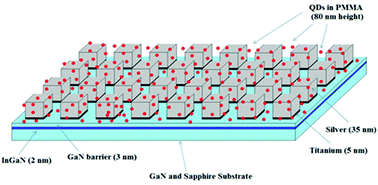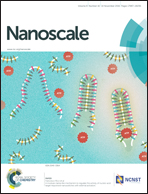Influence of plasmonic array geometry on energy transfer from a quantum well to a quantum dot layer†
Abstract
A range of seven different Ag plasmonic arrays formed using nanostructures of varying shape, size and gap were fabricated using helium-ion lithography (HIL) on an InGaN/GaN quantum well (QW) substrate. The influence of the array geometry on plasmon-enhanced Förster resonance energy transfer (FRET) from a single InGaN QW to a ∼80 nm layer of CdSe/ZnS quantum dots (QDs) embedded in a poly(methyl methacrylate) (PMMA) matrix is investigated. It is shown that the energy transfer efficiency is strongly dependent on the array properties and an efficiency of ∼51% is observed for a nanoring array. There were no signatures of FRET in the absence of the arrays. The QD acceptor layer emission is highly sensitive to the array geometry. A model was developed to confirm that the increase in the QD emission on the QW substrate compared with a GaN substrate can be attributed solely to plasmon-enhanced FRET. The individual contributions of direct enhancement of the QD layer emission by the array and the plasmon-enhanced FRET are separated out, with the QD emission described by the product of an array emission factor and an energy transfer factor. It is shown that while the nanoring geometry results in an energy transfer factor of ∼1.7 the competing quenching by the array, with an array emission factor of ∼0.7, results in only an overall gain of ∼14% in the QD emission. The QD emission was enhanced by ∼71% for a nanobox array, resulting from the combination of a more modest energy transfer factor of 1.2 coupled with an array emission factor of ∼1.4.


 Please wait while we load your content...
Please wait while we load your content...